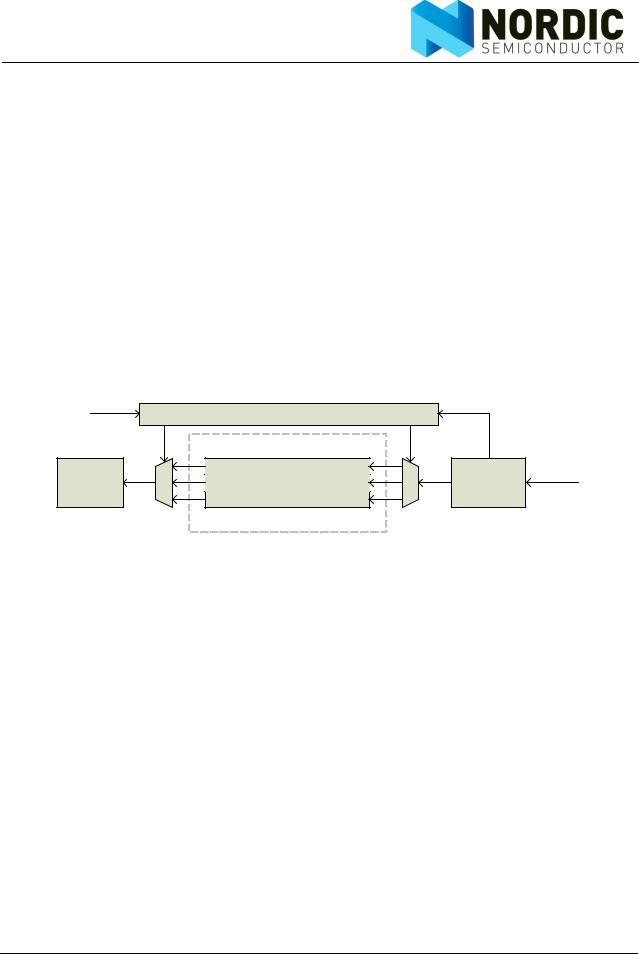
- •1 Introduction
- •1.1 Features
- •1.2 Block diagram
- •2 Pin Information
- •2.1 Pin assignment
- •2.2 Pin functions
- •3 Absolute maximum ratings
- •4 Operating conditions
- •5 Electrical specifications
- •5.1 Power consumption
- •5.2 General RF conditions
- •5.3 Transmitter operation
- •5.4 Receiver operation
- •5.5 Crystal specifications
- •5.6 DC characteristics
- •5.7 Power on reset
- •6 Radio Control
- •6.1 Operational Modes
- •6.1.1 State diagram
- •6.1.2 Power Down Mode
- •6.1.3 Standby Modes
- •6.1.4 RX mode
- •6.1.5 TX mode
- •6.1.6 Operational modes configuration
- •6.1.7 Timing Information
- •6.2 Air data rate
- •6.3 RF channel frequency
- •6.4 Received Power Detector measurements
- •6.5 PA control
- •6.6 RX/TX control
- •7 Enhanced ShockBurst™
- •7.1 Features
- •7.2 Enhanced ShockBurst™ overview
- •7.3.1 Preamble
- •7.3.2 Address
- •7.3.3 Packet control field
- •7.3.3.1 Payload length
- •7.3.3.2 PID (Packet identification)
- •7.3.4 Payload
- •7.3.5 CRC (Cyclic Redundancy Check)
- •7.3.6 Automatic packet assembly
- •7.3.7 Automatic packet disassembly
- •7.4 Automatic packet transaction handling
- •7.4.1 Auto acknowledgement
- •7.4.2 Auto Retransmission (ART)
- •7.5 Enhanced ShockBurst flowcharts
- •7.5.1 PTX operation
- •7.5.2 PRX operation
- •7.8.1 Single transaction with ACK packet and interrupts
- •7.8.2 Single transaction with a lost packet
- •7.8.3 Single transaction with a lost ACK packet
- •7.8.4 Single transaction with ACK payload packet
- •7.8.5 Single transaction with ACK payload packet and lost packet
- •7.8.6 Two transactions with ACK payload packet and the first ACK packet lost
- •7.8.7 Two transactions where max retransmissions is reached
- •7.9 Compatibility with ShockBurst™
- •7.9.1 ShockBurst™ packet format
- •8 Data and Control Interface
- •8.1 Features
- •8.2 Functional description
- •8.3 SPI operation
- •8.3.1 SPI commands
- •8.3.2 SPI timing
- •8.4 Data FIFO
- •8.5 Interrupt
- •9 Register Map
- •9.1 Register map table
- •10 Peripheral RF Information
- •10.1 Antenna output
- •10.2 Crystal oscillator
- •10.3 nRF24L01+ crystal sharing with an MCU
- •10.3.1 Crystal parameters
- •10.3.2 Input crystal amplitude and current consumption
- •10.4 PCB layout and decoupling guidelines
- •11 Application example
- •11.1 PCB layout examples
- •12 Mechanical specifications
- •13 Ordering information
- •13.1 Package marking
- •13.2 Abbreviations
- •13.3 Product options
- •13.3.1 RF silicon
- •13.3.2 Development tools
- •14 Glossary of Terms
- •Appendix A - Enhanced ShockBurst™ - Configuration and communication example
- •Enhanced ShockBurst™ transmitting payload
- •Enhanced ShockBurst™ receive payload
- •Appendix B - Configuration for compatibility with nRF24XX
- •Appendix C - Constant carrier wave output for testing
- •Configuration

nRF24L01+ Product Specification
7.4Automatic packet transaction handling
Enhanced ShockBurst™ has two functions for automatic packet transaction handling; auto acknowledgement and auto re-transmit.
7.4.1Auto acknowledgement
Auto acknowledgment is a function that automatically transmits an ACK packet to the PTX after it has received and validated a packet. The auto acknowledgement function reduces the load of the system MCU and can remove the need for dedicated SPI hardware. This also reduces cost and average current consumption. The Auto Acknowledgement feature is enabled by setting the EN_AA register.
Note: If the received packet has the NO_ACK flag set, auto acknowledgement is not executed.
An ACK packet can contain an optional payload from PRX to PTX. In order to use this feature, the Dynamic Payload Length (DPL) feature must be enabled. The MCU on the PRX side has to upload the payload by clocking it into the TX FIFO by using the W_ACK_PAYLOAD command. The payload is pending in the TX FIFO (PRX) until a new packet is received from the PTX. nRF24L01+ can have three ACK packet payloads pending in the TX FIFO (PRX) at the same time.
RX Pipe |
Address decoder and buffer controller |
|
|
|
address |
|
|
||
|
TX Pipe |
|
||
|
|
|
||
|
TX FIFO |
address |
|
|
ACK |
Payload 3 |
SPI |
From |
|
Payload 2 |
||||
generator |
Module |
MCU |
||
Payload 1 |
||||
|
|
|
Figure 9. TX FIFO (PRX) with pending payloads
Figure 9. shows how the TX FIFO (PRX) is operated when handling pending ACK packet payloads. From the MCU the payload is clocked in with the W_ACK_PAYLOAD command. The address decoder and buffer controller ensure that the payload is stored in a vacant slot in the TX FIFO (PRX). When a packet is received, the address decoder and buffer controller are notified with the PTX address. This ensures that the right payload is presented to the ACK generator.
If the TX FIFO (PRX) contains more than one payload to a PTX, payloads are handled using the first in – first out principle. The TX FIFO (PRX) is blocked if all pending payloads are addressed to a PTX where the link is lost. In this case, the MCU can flush the TX FIFO (PRX) by using the FLUSH_TX command.
In order to enable Auto Acknowledgement with payload the EN_ACK_PAY bit in the FEATURE register must be set.
7.4.2Auto Retransmission (ART)
The auto retransmission is a function that retransmits a packet if an ACK packet is not received. It is used in an auto acknowledgement system on the PTX. When a packet is not acknowledged, you can set the number of times it is allowed to retransmit by setting the ARC bits in the SETUP_RETR register. PTX enters RX mode and waits a short period for an ACK packet each time a packet is transmitted. The time period the PTX is in RX mode is based on the following conditions:
Revision 1.0 |
Page 33 of 78 |

nRF24L01+ Product Specification
•Auto Retransmit Delay (ARD) has elapsed.
•No address match within 250µs (or 500µs in 250kbps mode).
•After received packet (CRC correct or not).
nRF24L01+ asserts the TX_DS IRQ when the ACK packet is received.
nRF24L01+ enters standby-I mode if there is no more untransmitted data in the TX FIFO and the CE pin is low. If the ACK packet is not received, nRF24L01+ goes back to TX mode after a delay defined by ARD and retransmits the data. This continues until acknowledgment is received, or the maximum number of retransmits is reached.
Two packet loss counters are incremented each time a packet is lost, ARC_CNT and PLOS_CNT in the OBSERVE_TX register. The ARC_CNT counts the number of retransmissions for the current transaction. You reset ARC_CNT by initiating a new transaction. The PLOS_CNT counts the total number of retransmissions since the last channel change. You reset PLOS_CNT by writing to the RF_CH register. It is possible to use the information in the OBSERVE_TX register to make an overall assessment of the channel quality.
The ARD defines the time from the end of a transmitted packet to when a retransmit starts on the PTX. ARD is set in SETUP_RETR register in steps of 250µs. A retransmit is made if no ACK packet is received by the PTX.
There is a restriction on the length of ARD when using ACK packets with payload. The ARD time must never be shorter than the sum of the startup time and the time on-air for the ACK packet:
•For 2Mbps data rate and 5 byte address; 15 byte is maximum ACK packet payload length for ARD=250µs (reset value).
•For 1Mbps data rate and 5 byte address; 5 byte is maximum ACK packet payload length for ARD=250µs (reset value).
ARD=500µs is long enough for any ACK payload length in 1 or 2Mbps mode.
•For 250kbps data rate and 5byte address the following values apply:
ARD |
ACK packet size (in bytes) |
1500µs |
All ACK payload sizes |
1250µs |
< 24 |
1000µs |
< 16 |
750µs |
< 8 |
500µs |
Empty ACK with no payload |
Table 18. Maximum ACK payload length for different retransmit delays at 250kbps
As an alternative to Auto Retransmit it is possible to manually set the nRF24L01+ to retransmit a packet a number of times. This is done by the REUSE_TX_PL command. The MCU must initiate each transmission of the packet with a pulse on the CE pin when this command is used.
Revision 1.0 |
Page 34 of 78 |
